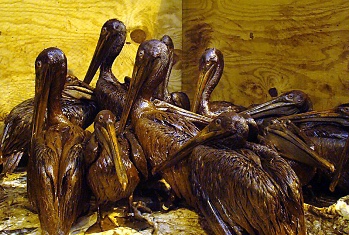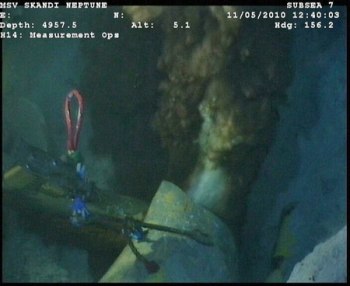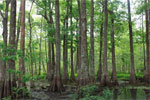Will we ever know the full wildlife toll of the BP oil spill? The short answer: no. The gruesome photos that are making the media rounds over the last week of oiled birds, fish, and crustaceans are according to experts only a small symbol of the ecological catastrophe that is likely occurring both in shallow and deep waters.
Due to the photos, birds, especially the brown pelican, have become the symbol of the spill to date. But while dozens of birds have been brought to rescue stations covered in oil, the vast majority will die out at sea far from human eyes and snapping cameras, according to Sharon Taylor a vet with the US Fish and Wildlife Service. Taylor told the AFP that the 550 dead oiled birds have been found to date, but that was likely a “small number” of the total.
Some marsh bird species are also unlikely to ever be found. Melanie Driscoll of the National Audubon Society told the AP that some species inhabiting Louisiana’s marshes will simply disappear like the clapper rail, the seaside sparrow, and the mottled duck. Yet, as much press as the birds are receiving their suffering and deaths are merely a drop in the bucket of the damage that is happening across the gulf.
 Oiled brown pelicans captured at Grand Isle, Louisiana on Thursda, June 3, 2010 wait to be cleaned of Gulf spill crude at The Fort Jackson Wildlife Care Center in Buras, Louisiana. Photo courtesy of International Bird Rescue Research Center. |
For fish the oil spill couldn’t have happened at a worst time: spawning season. While adult fish may be able to avoid the oil, their young will not. Fishermen fear for the next generation of shrimp, bluefin tuna, and king mackerel.
Conservationists fear that one victim of the oil spill will be the smalltooth sawfish, which is listed as Critically Endangered by the IUCN Red List. Devastated by fisheries—both as a targeted species and as bycatch—the species has plunged to between 1-5 percent of its historic population. Could the oil spill lead to its extinction? No one knows and it will be years before researchers are able to determine how the sawfish fares against this latest catastrophe.
People have found perished sea turtles in the hundreds (far higher number than usual), yet it’s impossible to know how many sea turtles are dying in the sea without their bodies washing ashore.
The Gulf of Mexico also has a resident population of some 1600 sperm whales. Little-studied and mysterious, sperm whales inhabit deep waters and it’s unlikely their corpses will ever wash up on land. Celine Godard-Codding, an environmental toxicologist at Texas Tech University, recently told National Geographic that if the oil exposure kills just three sperm whale individuals it could affect the population’s long term survival, given that the whales are slow breeding. Sperm whales are listed as Vulnerable by the IUCN Red List: drowning in nets and pollution are thought to be the biggest killers.
 Still photo of live feed of Gulf oil spill in cooperation with BP. Photo courtesy of the US government. |
But what about smaller, less media-savvy species, such as the microorganisms that many marine animals depend on for food? No one collects numbers on these species, but Greg Bossart, the chief veterinary officer and a senior vice president with the Georgia Aquarium, told the Atlanta Journal-Constitution: “this spill is novel because it is spilling from a depth of 1 mile and has not stopped in over a month and continues to grow. Because many of the effects are difficult to observe, they may appear subtle but could actually be more profound in the long run because the oil impacts the microorganisms that make up the base of the various food chains involved.”
Bossart admits that “we do not have a good historical template to work from to predict the long-term damage.”
Oil at deep water is of grave concern for the entire marine ecosystem, which is one reason why BP is denying scientists’ reports of ‘oil plumes’ far beneath the surface. Coral reefs, the rainforests of the marine world in terms of biodiversity, could be suffocated by oil coating.
“Unfortunately, the depth at which the oil is coming out of the well is home to the greatest diversity of species in the entire Gulf region,” Thomas Shirley of the Harte Research Institute explained to Spiegel Online.
As of Sunday, the US Fish and Wildlife Service put the wildlife death toll at 597 birds, 243 sea turtles, and 31 mammals, including dolphins. Some of these animals, however, wait testing to uncover if oil played a role in their death.
But how many animals have actually perished—and how many will succumb due to long-term effects—is impossible to say. What isn’t impossible to say is that the Gulf of Mexico’s ecosystems will take decades (if not more) to recover and some species and resident populations may never recover, disappearing forever.
Related articles
Before the oil spill (photos)

(06/03/2010) With the BP oil spill continuing unabated into the 2010 Atlantic hurricane season, fears are rising that a major storm could dramatically worsen the impact of the disaster, which has already been called the worst in U.S. history. Forecasters are predicting 14 to 23 named storms this year, of which 3 to 7 will turn into major hurricanes. According to forecasters Philip Klotzbach and William Gray of Colorado State University, there is a 43 percent chance that Louisiana will be hit by a hurricane.
As Mangroves Die from Oil, U.S. Public Yawns
(06/03/2010) What if, instead of a nasty oil disaster in the Gulf of Mexico, the U.S. public was now confronted with a natural catastrophe in the Grand Canyon or in California Redwood forests? Within the popular imagination, certain types of ecosystems elicit more sympathy than others, and very low on the totem pole are mangrove forests. Located in the tropics, mangroves are a mess of thick, tangled salt-tolerant trees and shrubs which thrive in brackish tidal waters. When I paddled through the Florida Everglades in a canoe some fifteen years ago, I found mangroves bizarre looking: trees have long roots which stick out above the water level.
The Gulf oil spill in context: US oil consumption
(05/31/2010) The US government has now confirmed that the oil spill in the Gulf of Mexico is the United States’ largest oil spill and perhaps the nation’s worst environmental disaster. While poor government oversight and negligence by oil giant BP certainly contributed to the disaster, the fact that the US is drilling over a mile below the surface in one of its most important marine ecosystems is directly related to US consumption of oil: the highest in the world.
Researchers begin studying long-term effects of oil spill on marine life
(05/25/2010) As a White House official today announced that the oil spill in the Gulf of Mexico is the worst in US history—surpassing even the Exxon Valdez spill in Alaska in 1989 (which is still affecting the area today)—marine biologist are beginning to prepare studies to monitor how the spill will impact the gulf in the long-term.
BP and the Perilous Voyage of Bama the Manatee

(05/23/2010) To the degree that Americans are paying attention to the environmental plight of marine wildlife in the Gulf of Mexico, they may focus most upon dolphins and whales. However, the U.S. public is much less familiar with another marine mammal, the manatee, which could also be placed in jeopardy as a result of the BP oil spill. One of the most outlandish creatures on the planet, the shy and retiring manatee, which gets its name from an American Indian word meaning “Lady of the Water”, is one of my favorite animals.
Wildlife death toll from BP oil spill likely includes dolphins

(05/13/2010) The oil spill in the Gulf of Mexico is taking its toll on the region’s wildlife: brown pelicans, sea turtles, several species of fish, and now dolphins have been found dead. The National Marine Fisheries Service reported today finding six dead dolphins in Louisiana, Mississippi, and Alabama since May 2nd. Officials are saying the deaths could be related to the oil spill or may be due to natural deaths from calving. They are currently testing tissue samples to determine if oil pollution was a cause of death. Dolphins have been observed swimming in oil-stained waters off of Louisiana.
Who’s to blame for the oil spill?

(05/04/2010) America, we deserve the oil spill now threatening the beautiful coast of Louisiana. This disaster is not natural, like the earthquake that devastated Haiti or tsunami that swept Southeast Asia in 2006; this disaster is man-made, American-made in fact, pure and simple. So, while in the upcoming weeks and months—if things go poorly—we may decry the oil-drenched wildlife, the economic loss for the region, the spoiled beeches, the wrecked ecosystems, the massive disaster that could take decades if not longer to recover from, we, as Americans, cannot think smugly that we are somehow innocent of what has happened. You play with fire: you will get burned. You drill for oil 1,500 meters below the surface of the ocean, you open up oil holes across the surface of your supposedly-beloved landscape, sooner or later there will be a spill, and sometimes that spill will be catastrophic.
Gulf oil spill could impact non-coastal songbirds
(05/03/2010) Even though they don’t stop over in the Gulf of Mexico, many migrating songbirds could be impacted by the catastrophic oil spill, warns the American Bird Conservancy (ABC). The threats to marine and coastal birds have been well-outlined during the past few days, however birds flying high above the spill could also be vulnerable.